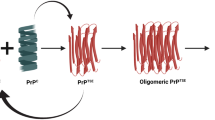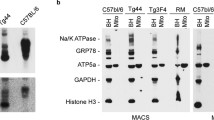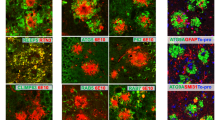Abstract
Immunogold electron microscopy has shown that the primary toxic effects on cells of disease-associated prion protein (PrPd) accumulation are to be found on plasma membranes. The nature of the membrane change is tissue and cell type specific. PrPd accumulation on neurites is associated with bizarre and unique twisted or branched membrane invaginations that are sometimes coated and sometimes have a spiral twist. Neuronal PrPd elicits submembrane ubiquitination by interaction with a presumptive transmembrane ligand and this protein complex undergoes clathrin-mediated endocytosis. PrPd accumulation on plasma membranes of glial cells causes membrane ruffling but on follicular dendritic cells of the lymphoid system it causes dendritic process hyperplasia, while on adrenal chromaffin cells it causes the membrane to be rearranged into linear palisades. PrPd interacts with different molecular partners on different cells suggesting that these different morphological defects are caused by variable molecular interactions related to a scaffolding function of normal membrane PrP. The presence of a glycophosphoinositol (GPI) anchor is necessary for membrane binding and pathology. The absence of a GPI anchor promotes release of PrPd into interstitial fluid and, on interaction with extracellular matrix binding proteins, its accumulation in basement membranes of blood vessels to form cerebral amyloid angiopathy. Membrane PrPd may be released to the extracellular space to form amyloid fibrils or be internalized into the endolysosomal systems where it is initially N-terminally truncated prior to complete degradation. These three subcellular locations of PrPd, plasma membranes, endolysosomes, and extracellular aggregates of PrPd, are common to all classical prion diseases and prion disease sources in man, sheep, cattle, and deer. However, atypical scrapie PrPd may be found on membranes of myelinated axons and in the inner mesaxon of oligodendroglial cells suggesting that differing trafficking pathways for PrPd occur in atypical scrapie relative to classical prion diseases. While PrPd is consistently associated with cellular lesions that most likely contribute to neurological deficits, it is unlikely that PrPd colocalized lesions are, alone, the proximate cause of clinical disease. Other lesions such as apoptosis that do not colocalize with PrPd may contribute to clinical disease progression and may be associated indirectly with increasing PrPd accumulation. However, prion disease-infected tissues possess other lesions, such as tubulovesicular bodies, that do not have clear association with PrPd and are of unknown relationship to disease pathogenesis.
Access this chapter
Tax calculation will be finalised at checkout
Purchases are for personal use only
Similar content being viewed by others
References
González L, Terry L, Jeffrey M (2005) Expression of prion protein in the gut of mice infected orally with the 301V murine strain of the bovine spongiform encephalopathy agent. J Comp Pathol 132(4):273–282
Jeffrey M, Martin S, González L (2003) Cell-associated variants of disease-specific prion protein immunolabelling are found in different sources of sheep transmissible spongiform encephalopathy. J Gen Virol 84(4):1033–1046
González L, Martin S, Houston FE, Hunter N, Reid HW, Bellworthy SJ, Jeffrey M (2005) Phenotype of disease-associated PrP accumulation in the brain of bovine spongiform encephalopathy experimentally infected sheep. J Gen Virol 86(3):827–838
Kovacs GG, Head MW, Hegyi I, Bunn TJ, Flicker H, Hainfellner JA, McCardle L, Laszlo L, Jarius C, Ironside JW, Budka H (2002) Immunohistochemistry for the prion protein: comparison of different monoclonal antibodies in human prion disease subtypes. Brain Pathol 12(1):1–11
Farquhar CF, Sommerville RA, Ritchie LA (1989) Post mortem immunodiagnosis of scrapie and bovine spongiform encephalopathy. J Virol Methods 24:215–222
Choi JK, Park SJ, Jun YC, Oh JM, Jeong BH, Lee HP, Park SN, Carp RI, Kim YS (2006) Generation of monoclonal antibody recognized by the GXXXG motif (glycine zipper) of prion protein. Hybridoma (Larchmt) 25(5):271–277
Caughey B, Raymond G (1991) The scrapie-associated form of PrP is made from a cell surface precursor that is both protease- and phospholipase-sensitive. J Biol Chem 266(27):18217–18223
Baron GS, Wehrly K, Dorward DW, Chesebro B, Caughey B (2002) Conversion of raft associated prion protein to the protease-resistant state requires insertion of PrP-res (PrPSc) into contiguous membranes. EMBO J 21(5):1031–1040
Caughey B, Baron GS, Chesebro B, Jeffrey M (2009) Getting a grip on prions: oligomers, amyloids, and pathological membrane interactions. Annu Rev Biochem 78(1):177–204
Jeffrey M, McGovern G, Chambers EV, King D, González L, Manson JC, Ghetti B, Piccardo P, Barron RM (2012) Mechanism of PrP-amyloid formation in mice without transmissible spongiform encephalopathy. Brain Pathol 22(1):58–66
Piccardo P, King D, Telling G, Manson JC, Barron RM (2013) Dissociation of prion protein amyloid seeding from transmission of a spongiform encephalopathy. J Virol 87(22):12349–12356
Jeffrey M, McGovern G, Sisó S, González L (2011) Cellular and sub-cellular pathology of animal prion diseases: relationship between morphological changes, accumulation of abnormal prion protein and clinical disease. Acta Neuropathol 121(1):113–134
Jeffrey M, McGovern G, Goodsir CM, González L (2009) Strain-associated variations in abnormal PrP trafficking of sheep scrapie. Brain Pathol 19(1):1–11
Harris DA (1997) Cell biological studies of the prion protein. In: Harris DA (ed) Prions: molecular and cellular biology. Horizon Scientific Press, Wymondham, pp 53–65
Linden R, Cordeiro Y, Lima LM (2012) Allosteric function and dysfunction of the prion protein. Cell Mol Life Sci 69(7):1105–1124
Jeffrey M, McGovern G, Makarava N, Gonzalez L, Kim JS, Rohwer RG, Baskakov IV (2013) Pathology of SSLOW, a transmissible and fatal synthetic prion protein disorder and comparison with naturally occurring classical Transmissible Spongiform Encephalopathies. Neuropathol Appl Neurobiol 40:296–310
Beringue V, Demoy M, Lasmezas CI, Gouritin B, Weingarten C, Deslys JP, Andreux JP, Couvreur P, Dormont D (2000) Role of spleen macrophages in the clearance of scrapie agent early in pathogenesis. J Pathol 190(4):495–502
Nimmerjahn A, Kirchhoff F, Helmchen F (2005) Resting microglial cells are highly dynamic surveillants of brain parenchyma in vivo. Science 308(5726):1314–1318
Jeffrey M, McGovern G, Barron R, Baumann F (2015) Membrane pathology and microglial activation of mice expressing membrane anchored or membrane released forms of Abeta and mutated human APP. Neuropathol Appl Neurobiol 41(4):458–470
Ersdal C, Simmons MM, Goodsir C, Martin S, Jeffrey M (2003) Sub-cellular pathology of scrapie: coated pits are increased in PrP codon 136 alanine homozygous scrapie-affected sheep. Acta Neuropathol 106(1):17–28
Wang X, McGovern G, Zhang Y, Wang F, Zha L, Jeffrey M, Ma J (2015) Intraperitoneal infection of wild-type mice with synthetically generated mammalian prion. PLoS Pathog 11(7):e1004958
Bastian FO (1979) Spiroplasma-like inclusions in Creutzfeldt-Jakob disease. Arch Pathol Lab Med 103(13):665–669
Liberski PP, Yanagihara R, Wells GAH, Gajdusek DC (1993) Neuronal degeneration in unconventional slow virus disorders. In: Liberski PP (ed) Light and electron microscopic neuropathology of slow virus disorders. CRC Press, Boca Raton, pp 349–371
Jeffrey M, Goodsir CM, Race RE, Chesebro B (2004) Scrapie-specific neuronal lesions are independent of neuronal PrP expression. Ann Neurol 55(6):781–792
Ilangumaran S, Robinson PJ, Hoessli DC (1996) Transfer of exogenous glycosylphos-phatidylinositol (GPI)-linked molecules to plasma membranes. Trends Cell Biol 6(5):163–167
Chesebro B, Race B, Meade-White K, LaCasse R, Striebel J, Klingeborn M, Race R, McGovern G, Dorward D, Jeffrey M (2010) Fatal transmissible amyloid encephalopathy: a new type of prion disease associated with lack of prion protein membrane anchoring. PLoS Pathog 6(3):e1000800
Jeffrey M, González L (2004) Pathology and pathogenesis of bovine spongiform encephalopathy and scrapie. In: Harris D (ed) Mad cow disease and related spongiform encephalopathies. Springer, Berlin, pp 65–97
Casalone C, Zanusso G, Acutis P, Ferrari S, Capucci L, Tagliavini F, Monaco S, Caramelli M (2004) Identification of a second bovine amyloidotic spongiform encephalopathy: molecular similarities with sporadic Creutzfeldt-Jakob disease. Proc Natl Acad Sci U S A 101(9):3065–3070
Parchi P, Strammiello R, Notari S, Giese A, Langeveld JP, Ladogana A, Zerr I, Roncaroli F, Cras P, Ghetti B, Pocchiari M, Kretzschmar H, Capellari S (2009) Incidence and spectrum of sporadic Creutzfeldt-Jakob disease variants with mixed phenotype and co-occurrence of PrP(Sc) types: an updated classification. Acta Neuropathol 118(5):659–671
Head M, Ironside JI, Ghetti B, Jeffrey M, Piccardo P, Will RG (2015) Prion diseases. In: Greenfield’s neuropathology, vol 2, 9th edn. CRC Press, Boca Raton, pp 1016–1086
Revesz T, Holton JL, Lashley T, Plant G, Frangione B, Rostagno A, Ghiso J (2009) Genetics and molecular pathogenesis of sporadic and hereditary cerebral amyloid angiopathies. Acta Neuropathol 118(1):115–130
Jeffrey M, Goodsir CM, Bruce ME, McBride PA, Farquhar C (1994) Morphogenesis of amyloid plaques in 87V murine scrapie. Neuropathol Appl Neurobiol 20(6):535–542
Liberski PP, Guiroy DC, Williams ES, Yanagihara R, Brown P, Gajducek DC (1992) The amyloid plaque. In: Liberski PP (ed) Light and electron microscopic neuropathology of slow virus disorders. CRC press, Boca Raton, pp 295–347
Sikorska B, Liberski PP, Sobow T, Budka H, Ironside JW (2009) Ultrastructural study of florid plaques in variant Creutzfeldt-Jakob disease: a comparison with amlyoid plaqes in kuru, Creutzfeldt-Jakob disease and Gerstamnn-Straussler-Scheinker disease. Neuropathol Appl Neurobiol 35(1):46–59
Boellaard JW, Schlote W, Heldt N (1989) The development of amyloid plaques in human transmissible encephalopathy and the role of astrocytes in their formation, Paris 2–6 December 1986. In: Court LA, Dormont D, Brown P, Kingsbury DT (eds) Unconventional virus diseases of the central nervous system. Commissariat à l’Energie Atomique, Fontenay-aux-Roses, Paris, pp 162–171
Guiroy D, Williams E, Liberski P, Wakayama I, Gajdusek D (1993) Ultrastructural neuropathology of chronic wasting disease in captive mule deer. Acta Neuropathol 85(4):437–444
Jeffrey M, Goodsir CM, Holliman A, Higgins RJ, Bruce ME, McBride PA, Fraser JR (1998) Determination of the frequency and distribution of vascular and parenchymal amyloid with polyclonal and N-terminal-specific PrP antibodies in scrapie-affected sheep and mice. Vet Rec 142(20):534–537
Carare RO, Hawkes CA, Jeffrey M, Kalaria RN, Weller RO (2013) Review: cerebral amyloid angiopathy, prion angiopathy, CADASIL and the spectrum of protein elimination failure angiopathies (PEFA) in neurodegenerative disease with a focus on therapy. Neuropathol Appl Neurobiol 39(6):593–611
Chesebro B, Trifilo M, Race R, Meade-White K, Teng C, LaCasse R, Raymond L, Favara C, Baron G, Priola S, Caughey B, Masliah E, Oldstone M (2005) Anchorless prion protein results in infectious amyloid disease without clinical scrapie. Science 308(5727):1435–1439
Rangel A, Race B, Striebel J, Chesebro B (2013) Non-amyloid and amyloid prion protein deposits in prion-infected mice differ in blockage of interstitial brain fluid. Neuropathol Appl Neurobiol 39(3):217–230
Makarava N, Kovacs GG, Savtchenko R, Alexeeva I, Ostapchenko VG, Budka H, Rohwer RG, Baskakov IV (2012) A new mechanism for transmissible prion diseases. J Neurosci 32(21):7345–7355
Makarava N, Kovacs GG, Bocharova O, Savtchenko R, Alexeeva I, Budka H, Rohwer RG, Baskakov IV (2010) Recombinant prion protein induces a new transmissible prion disease in wild-type animals. Acta Neuropathol 119(2):177–187
Jeffrey M (2013) Review: membrane-associated misfolded protein propagation in natural transmissible spongiform encephalopathies (TSEs), synthetic prion diseases and Alzheimer’s disease. Neuropathol Appl Neurobiol 39(3):196–216
Walker LC, Callahan MJ, Bian F, Durham RA, Roher AE, Lipinski WJ (2002) Exogenous induction of cerebral beta-amyloidosis in beta APP-transgenic mice. Peptides 23(7):1241–1247
Carare RO, Bernardes-Silva M, Newman TA, Page AM, Nicoll JAR, Perry VH, Weller RO (2012) Solutes, but not cells, drain from the brain parenchyma along basement membranes of capillaries and arteries: significnace for cerebral amyloid angiopathy and neuroimmunology. Neuropathol Appl Neurobiol 34:131–144
Zhang ET, Richards HK, Kida S, Weller RO (1992) Directional and compartmentalised drainage of interstitial fluid and cerebrospinal fluid from the rat brain. Acta Neuropathol 83(3):233–239
Benestad SL, Arsac JN, Goldmann W, Noremark M (2008) Atypical/Nor98 scrapie: properties of the agent, genetics, and epidemiology. Vet Res 39(4):19
Goldmann W (2008) PrP genetics in ruminant transmissible spongiform encephalopathies. Vet Res 39(4):30
Le Dur A, Beringue V, Andreoletti O, Reine F, Lai TL, Baron T, Bratberg B, Vilotte JL, Sarradin P, Benestad SL, Laude H (2005) A newly identified type of scrapie agent can naturally infect sheep with resistant PrP genotypes. Proc Natl Acad Sci U S A 102(44):16031–16036
Simmons MM, Konold T, Thurston L, Bellworthy SJ, Chaplin MJ, Moore SJ (2010) The natural atypical scrapie phenotype is preserved on experimental transmission and sub-passage in PRNP homologous sheep. BMC Vet Res 6(1):14
Jeffrey M, González L, Simmons MM, Hunter N, Martin S, McGovern G (2017) Altered trafficking of abnormal prion protein in atypical scrapie: prion protein accumulation in oligodendroglial inner mesaxons. Neuropathol Appl Neurobiol 43(3):215–226
Chiesa R, Piccardo P, Ghetti B, Harris DA (1998) Neurological illness in transgenic mice expressing a prion protein with an insertional mutation. Neuron 21(6):1339–1351
Jeffrey M, Goodsir C, McGovern G, Barmada SJ, Medrano AZ, Harris DA (2009) Prion protein with an insertional mutation accumulates on axonal and dendritic plasmalemma and is associated with distinctive ultrastructural changes. Am J Pathol 175(3):1208–1217
Medrano AZ, Barmada SJ, Biasini E, Harris DA (2008) GFP-tagged mutant prion protein forms intra-axonal aggregates in transgenic mice. Neurobiol Dis 31(1):20–32
Hemm RD, Carlton WW, Welser JR (1971) Ultrastructural changes of cuprizone encephalopathy in mice. Toxicol Appl Pharmacol 18(4):869–882
Barron RM, Campbell SL, King D, Bellon A, Chapman KE, Williamson RA, Manson JC (2007) High titers of transmissible spongiform encephalopathy infectivity associated with extremely low levels of PrPSc in vivo. J Biol Chem 282(49):35878–35886
Jeffrey M, González L (2007) Classical sheep transmissible spongiform encephalopathies: pathogenesis, pathological phenotypes and clinical disease. Neuropathol Appl Neurobiol 33(4):373–394
Jeffrey M, Fraser JR (2000) Tubulovesicular particles occur early in the incubation period of murine scrapie. Acta Neuropathol 99(5):525–528
Jeffrey M, McGovern G, Goodsir CM, Brown KL, Bruce ME (2000) Sites of prion protein accumulation in scrapie-infected mouse spleen revealed by immuno-electron microscopy. J Pathol 191(3):323–332
McGovern G, Brown KL, Bruce ME, Jeffrey M (2004) Murine scrapie infection causes an abnormal germinal centre reaction in the spleen. J Comp Pathol 130(2-3):181–194
McGovern G, Mabbott N, Jeffrey M (2009) Scrapie affects the maturation cycle and immune complex trapping by follicular dendritic cells in mice. PLoS One 4(12):e8186
Rademakers LHPM (1992) Dark and light zones of germinal centres of the human tonsil: an ultrastructural study with emphasis on heterogeneity of follicular dendritic cells. Cell Tissue Res 269(2):359–368
McGovern G, Jeffrey M (2007) Scrapie-specific pathology of sheep lymphoid tissues. PLoS One 2(12):e1304
Jeffrey M, Martin S, González L, Ryder SJ, Bellworthy SJ, Jackman R (2001) Differential diagnosis of infections with the bovine spongiform encephalopathy (BSE) and scrapie agents in sheep. J Comp Pathol 125(4):271–284
Sassa Y, Inoshima Y, Ishiguro N (2010) Bovine macrophage degradation of scrapie and BSE PrPSc. Vet Immunol Immunopathol 133(1):33–39
Sisó S, González L, Jeffrey M (2010) Neuroinvasion in prion diseases: the roles of ascending neural infection and blood dissemination. Interdiscip Perspect Infect Dis 2010:747892
Houston F, McCutcheon S, Goldmann W, Chong A, Foster J, Sisó S, González L, Jeffrey M, Hunter N (2008) Prion diseases are efficiently transmitted by blood transfusion in sheep. Blood 112(12):4739–4745
McGovern G, Jeffrey M (2013) Membrane toxicity of abnormal prion protein in adrenal chromaffin cells of scrapie infected sheep. PLoS One 8(3):e58620
Sisó S, Jeffrey M, Steele P, McGovern G, Martin S, Finlayson J, Chianini F, González L (2008) Occurrence and cellular localization of PrP(d) in kidneys of scrapie-affected sheep in the absence of inflammation. J Pathol 215(2):126–134
Race B, Jeffrey M, McGovern G, Dorward D, Prion CB (2017) Ultrastructure and pathology of prion protein amyloid accumulation and cellular damage in extraneural tissues of scrapie infected transgenic mice expressing anchorless prion protein. Epub ahead of print
Acknowledgements
This work was financially supported by Defra. We are grateful to the many collaborators who have made this work possible and to Callum Donnelly for expert technical assistance.
Author information
Authors and Affiliations
Corresponding author
Editor information
Editors and Affiliations
Rights and permissions
Copyright information
© 2017 Springer Science+Business Media LLC
About this protocol
Cite this protocol
Jeffrey, M., McGovern, G. (2017). Subcellular and Molecular Changes Associated with Abnormal PrP Accumulation in Brain and Viscera of Classical and Atypical Prion Diseases. In: Liberski, P. (eds) Prion Diseases. Neuromethods, vol 129. Humana Press, New York, NY. https://doi.org/10.1007/978-1-4939-7211-1_6
Download citation
DOI: https://doi.org/10.1007/978-1-4939-7211-1_6
Published:
Publisher Name: Humana Press, New York, NY
Print ISBN: 978-1-4939-7209-8
Online ISBN: 978-1-4939-7211-1
eBook Packages: Springer Protocols




